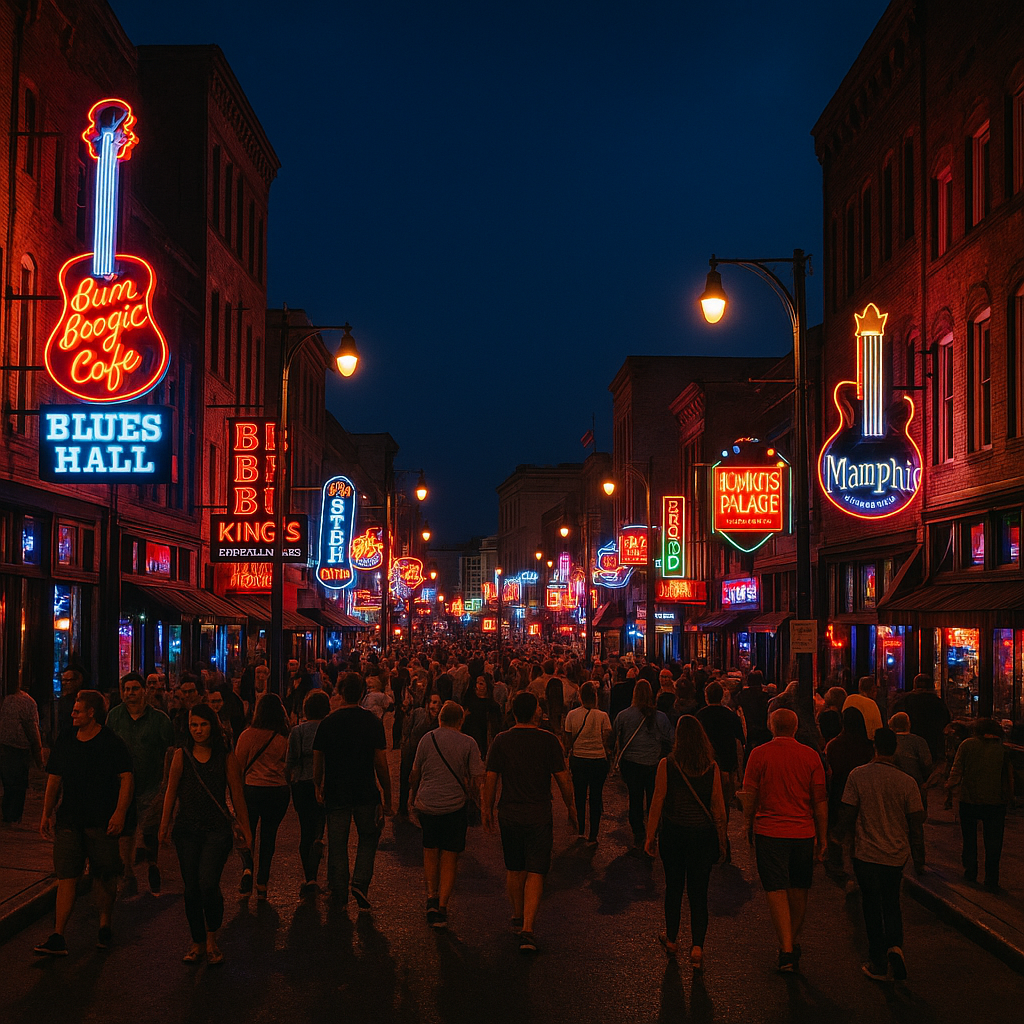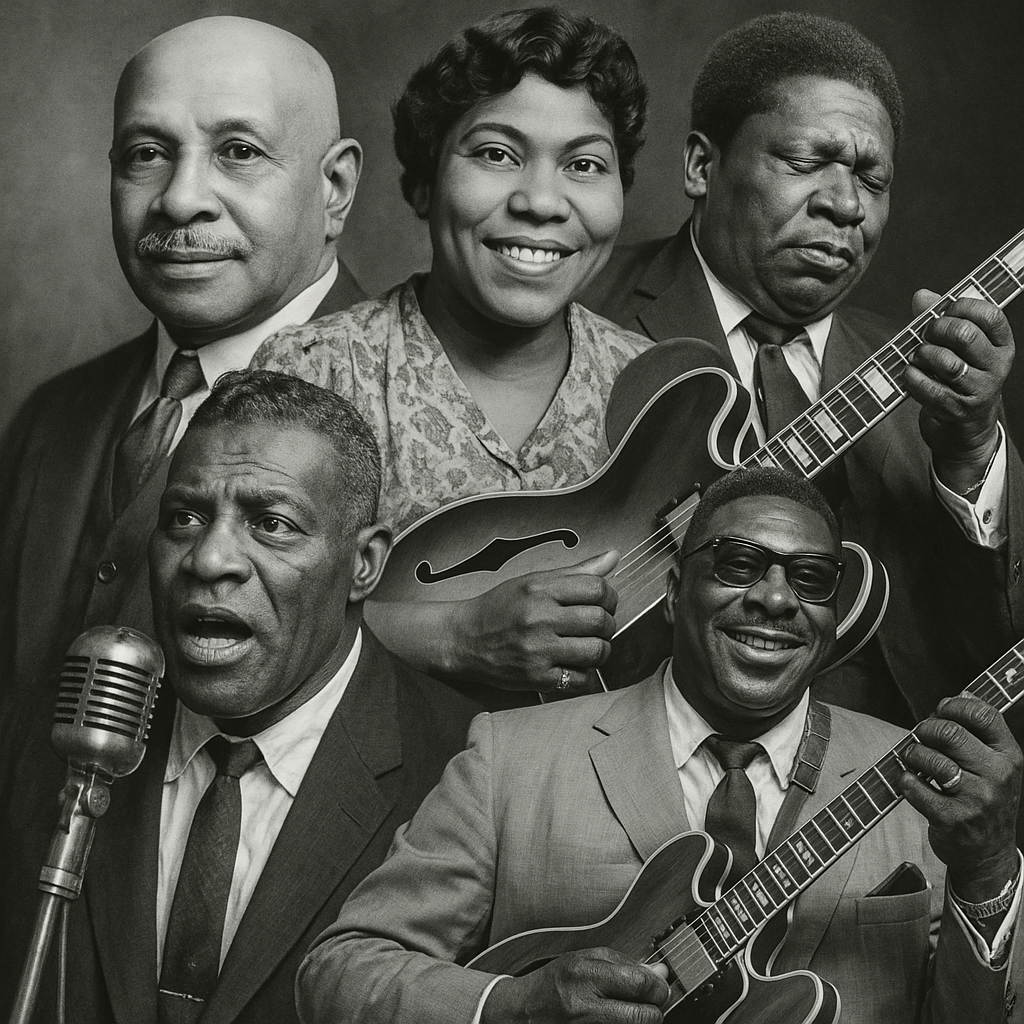Introduction
Neon signs flicker across Beale Street, pulsing with the sound of music pouring out of open doors and dark alleyways. Barbecue smoke drifts through the night air, mingling with the soulful cry of a guitar
In the past, legends like W.C. Handy, B.B. King, and Furry Lewis roamed this street. Their music told stories of struggle, celebration, and resilience, born from the soul of the city.
Memphis was not just a city; it was a fertile ground for blues musicians. Here, raw emotion was transformed into music that would go on to shape American culture.
In this article, we will introduce you to the pioneering artists who called Beale Street home. Their innovations and stories continue to inspire musicians worldwide.
W. C. Handy: Father of the Blues
In 1909 W.C. Handy first came to Memphis and lived near Beale Street. He heard music on the street, in train stations, and in juke joints.
He captured the street sounds in 1912 when he published ‘Memphis Blues. in sheet music form. In this form of written notation, this was a pivotal point in the history of the blues.
You can listen to “Memphis Blues” here.
Handy gave the blues form and structure. He put order to the 12-bar form, added arrangements and blended the folkloric roots with sheet music. He brought the blues out of the bars and into the mainstream.
Handy brought his music and his new form of blues to the country by touring with his band. He brought blues music to theaters, dance halls, and concert stages.
His music made many of his songs standards of the American songbook. Handy’s music and its notoriety gave credibility to the blues as a legitimate form of music to be documented and revered.
Blues music had expanded from the street corners and the juke joints to the national stage because of Handy. His contribution influenced the development of jazz, swing, and rock.
Memphis Minnie: Queen of the Guitar
Memphis Minnie was raised in Memphis, a place steeped in blues history and urban noise. In this city of music, Minnie learned her skills in the alleys and streets of her neighborhoods, as she was exposed to the sounds of the South.
In her early teens, Minnie developed her signature aggressive slide guitar technique. Her playing was sharp and strong, on par with the male contemporaries of her era.
The sidewalks and venues of Beale Street were her stomping ground. Minnie could be found playing for crowds and passersby, whether on the street or in jam-packed clubs.
She recorded over 200 songs in her career, her Delta-country origins merging with an edgier, more hardened style. Themes of tenacity and self-sufficiency were evident in her songs.
The image and mastery of Minnie challenged preconceived notions of female musicians in blues. She was among the first blueswomen to chart their artistic course.

B.B. King: Blues Boy King
B.B. got his start at WDIA radio in Memphis, where he worked as both a singer and a disc jockey. He acquired the nickname “Blues Boy,” which he later shortened to B.B.
The story of King’s guitar “Lucille” is a classic tale of danger and heroism. One night, he saved the instrument from a fire at a dance hall by retrieving it from the stage. To honor the woman the men where fighting over when the fire started, he named every one of his guitars “Lucille.”
King’s playing was as much about feeling as technique. His notes vibrated with yearning and longing. He spoke with the economy of speech, giving each note space to resonate.
Memphis clubs on Beale Street were King’s proving ground. Every show was a masterclass in showmanship and a study in blues.
Touring the world, B.B. King brought the blues to millions. His marathon performances, over 15,000 in all, served as inspiration to future generations.
Though he traveled the world, King never forgot his musical roots. He always gave thanks to Memphis and Beale Street for making him who he was.
The arc of B.B. King’s career was a testament to his talent and his spirit. From WDIA radio in Memphis to packed arenas, his music was about the blues of love, loss, and life.
B.B. King’s legacy is one of feeling, precision, and royalty.
You can read more about B.B. King here
Howlin’ Wolf: The Moody Shouter
Chester Burnett, better known as Howlin’ Wolf, migrated from Mississippi to Memphis in the early 1950s. With raw Delta power and larger-than-life presence, Wolf made his way to Memphis.
Wolf developed a growling, emotive style in Memphis. He would stomp, sweat, and wail on stage like a man on fire. Tall and towering with a menacing glare, he commanded the stage.
Wolf recorded early sessions at Sam Phillips’ Sun Studio. Phillips later described Wolf as the most intimidating talent he had ever encountered. These recordings became the first steps in Wolf’s recording career.
The intensity of Wolf’s music left a lasting impression on future generations. British rockers Mick Jagger and Eric Clapton borrowed from Wolf’s deep, growling sound. Songs such as “Smokestack Lightning” and “Moanin’ at Midnight” became blues standards.
You can listen to “Smokestack Lightnin'” here.
You can liisten to “Moanin’ at Midnight” here.
Howlin’ Wolf embodied the Mississippi Delta’s raw roots and the urban sass of his new home. With a voice rumbling like thunder and a show-stopping stage act, he set a high bar for musical intensity. No one was quite as forceful.
Wolf’s Memphis recordings and fiery performances influenced the future of rock ’n’ roll. His sound was primal, soulful, and unforgettable.
Read more abput Howlin’ Wolf here
Albert King: The Velvet Tone
Albert King started playing in Memphis clubs in the late 1940s and developed a substantial local following due to his powerful voice and charismatic stage presence. His early recordings mixed his gospel influences with a grittier electric edge.
King was an untrained lefty who played a right-handed Flying V flipped upside down. This gave him a unique tone with vocal-like bends and stinging string attack. His influential string-bending technique would become his trademark, and his solos were notable for their phrasing and emotional impact.
King’s signature song, “Born Under a Bad Sign,” encapsulated his style—slow and stodgy grooves with a crying, bluesy guitar lead filling the spaces in his vocals. The song would become a blues standard.
You can listen to “Born Under a Bad Sign” here.
Albert King played a heavy, smooth, and measured tone that fans often describe as “velvet”. He has been a significant influence on many rock and blues guitarists, including Stevie Ray Vaughan and Eric Clapton. King usually prioritized phrasing over speed.
King’s influence helped shape the sound of the modern electric blues guitar and paved the way for a new generation of expressive lead guitar players.
Booker T. and the M.G.s: Soulmakers
Booker T. & the MGs was a band from the early 1960s, who got together at the Stax record company in Memphis. Booker T. Jones, Steve Cropper, Lewie Steinberg, and Al Jackson Jr. were the members of the group.
They played groovy and soulful instrumentals, such as “Green Onions.” These songs were recorded at the legendary Stax studio. Their distinctive sound was both catchy and influential.
Booker T. & the MGs often served as the house band for the Stax record label. They played behind famous blues and soul artists, such as Otis Redding and Albert King. The group’s spirited playing gave those songs extra emotion and drive.
Their music was a fusion of blues, R&B, and Southern soul music. The group combined all these styles into a unified sound. Booker T. & the MGs were one of the tightest rhythm sections in music.
Their influence endures today, as their music was crucial in defining the Memphis soul sound. Musicians from all genres have been inspired by their sound.

Rosco Gordon: The “Rosco Scratch”
Rosco Gordon rose to prominence in Memphis juke joints. In these places he absorbed everything from blues to boogie and rhythm. His music thrived in the sweaty atmosphere of clubs packed with locals.
Gordon invented a style of piano rhythm called the “Roscoe Scratch.” This offbeat and syncopated approach gave his music a chunky, funky edge. Songs like “Booted” and “No More Doggin’” became R&B hits.
You can listen to “Booted” here.
You can listen to ” No More Dogin'” here.
His catchy rhythms would influence countless musicians outside of Memphis. The “Roscoe Scratch” was a favorite among Jamaican artists. It would go on to form the foundation of ska and reggae.
While he wasn’t always a household name, Rosco Gordon influenced genres across the world. His Southern blues and playful piano groove changed music.
Willie Mitchell: Sound Innovator
Willie Mitchell was a talented trumpeter who played in Memphis clubs in the 1950s. He soon gained a reputation as an adept arranger and attentive ear for session work around town.
Mitchell assumed leadership of Hi Records in the 1960s. He refined and expanded the label into a Southern soul machine of sleekness and swing.
Mitchell’s most important artist was Al Green, who was central to the “Memphis sound.” The approach was a polished, elegant blend of gospel spirit and rhythm, featuring swooning horns. Songs such as “Let’s Stay Together” and “Love and Happiness” became standards.
You can listen to “Love and Happiness” here.
You can listen to “Let’s Stay Together” here.
Restraint, a tight and clean rhythm section, and an emphasis on building and layering marked Mitchell’s production style. He mixed space and feeling in his mind rather than flash.
He would go on to influence soul and funk producers for decades to come, from Prince to D’Angelo. The sound he created was also an important demonstration of how less can be more.
Willie Mitchell was part of the transition of Memphis soul into something beyond the earthy grit of its early years. He left a sonic legacy and blueprint that resonates to this day.
Conclusion & Exploration
Memphis blues legends from Beale Street have included giants such as W.C. Handy, B.B. King, and many more. Each of these figures has their signature take on the blues that has defined them and their music.
Grounded in history, these artists have performed in Memphis clubs and recorded in Memphis studios, creating some of the most recognizable and enduring sounds and performances in the blues, soul, and rock genres.
Take a look at their greatest hits and recordings to capture the passion and grit of songs like “The Thrill Is Gone” and “Memphis Blues,” as well as other defining hits.
Visit Memphis to experience the musical history in person on Beale Street, through live performances and at the historic venues where so much great music was created and continues to live on to this day.
